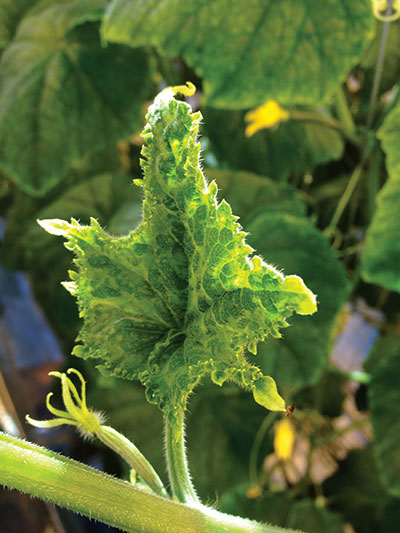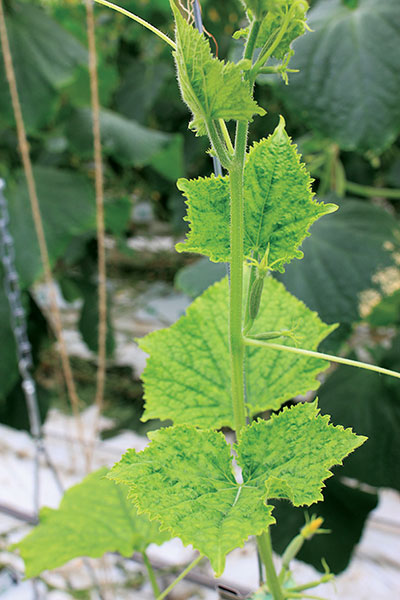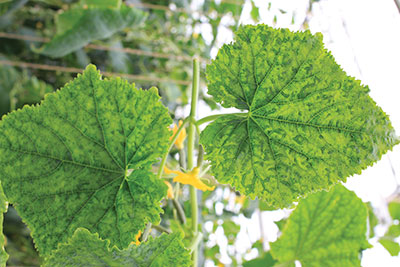
Features
Crop Protection
Inputs
New cucumber threat studied
March 10, 2014 By John W. Zhang Kai-Shu Ling and Ryan Cramer
On Jan. 16, 2013, Ryan Cramer posted a notice: “Just a heads up to all
cucumber growers, we have recently found and confirmed with a virus scan
that we have Cucumber Green Mottle Mosaic Virus (CGMMV) at County Fresh
Farms … This puts all cucumber growers in this area at risk.”
On Jan. 16, 2013, Ryan Cramer posted a notice: “Just a heads up to all cucumber growers, we have recently found and confirmed with a virus scan that we have Cucumber Green Mottle Mosaic Virus (CGMMV) at County Fresh Farms … This puts all cucumber growers in this area at risk.”
The symptoms of CGMMV were shown in his first report . The disease has been previously found and reported in greenhouses in Ontario, British Columbia and the Netherlands, and on field cucumber crops in Asia, Europe and the Middle East.
This was the first time that the virus was found in Alberta.

|
|
| Fig. 1 symptoms of CGMMV |
Fig. 1. Symptoms of Cucumber Green Mottle Mosaic Virus on young cucumber leaves in County Fresh Farms.
On April 15 of that year, John Zhang did his first greenhouse survey on the disease incidence, symptoms, severity and spreading patterns in the 15 acres of greenhouses of County Fresh Farms.
There are total of six compartments. Each compartment has 15 bays. Except for Compartment 4 (newly transplanted plants) and Compartment 3 (after a thorough cleanup in March), the disease incidence, in terms of the number of bays, meant the symptoms were found in almost all of the bays.
 |
|
| Fig. 2, CGMMV and MNSV.
|
Fig. 2a. The symptoms caused from both infections of CGMMV and Melon Necrotic Spot Virus (MNSV).
At the time of survey, the symptoms on some infected plants were compounded with the infections caused by Melon Necrotic Spot Virus, and Erwinia carotovora pv. carotovora The disease severity became greater with the complex of multiple infections.
SPREADING PATTERN STAYED ALONG SAME ROW DIRECTION
The spreading pattern primarily has been staying along the same row direction, which means mechanical transmission plays a major role for CGMMV transmission. The yield loss in the previous crops ranged 10 to 15 per cent, according to Ryan Cramer.
The plant samples were collected from Compartments 1, 2, 5 and 6 and sent to Dr. Kai-Shu Ling, Vegetable Laboratory, USDA-ARS, Charleston, South Carolina, for further analysis. No sample was collected from Compartments 3 and 4.
 |
|
| Fig. 2b. The symptoms caused from both infections of CGMMV and Melon Necrotic Spot Virus (MNSV).
|
Laboratory analyses using a sensitive molecular detection method (namely real-time RT-PCR) detected the presence of CGMMV in all nine cucumber samples, while seven of the nine samples were in a mixed infection with MNSV.
Partial genome sequence analysis showed 99 per cent sequence identity to CGMMV isolates identified in Asia, but only 92 per cent sequence identity to CGMMV isolates identified in Europe, and 95 per cent to CGMMV isolates from Israel.
Although the exact source of virus inoculum causing the disease epidemic in greenhouse cucumbers in Alberta has not been determined, the stronger sequence identity to the Asian isolates suggest that the CGMMV isolate from Alberta was likely an Asian origin.
The virus infectivity was confirmed in two bioassay experiments through mechanical inoculation on cucumbers (cv. ‘Marketer,’ cv. ‘Poinsett 76,’ cv. ‘Straight Eight,’ cv. ‘Athena’), Cucumis metulifer, and watermelon cv. ‘Charleston Gray.’
Similar Green Mottle Mosaic symptoms were produced on all inoculated cucurbit plants and the presence of CGMMV was confirmed through additional lab test. The efficient transmissibility of CGMMV posts a potential threat to greenhouse and field cucurbit growers in Alberta and elsewhere. ■
Report authors are John W. Zhang, Alberta Agriculture and Rural Development, Brook; Kai-Shu Ling, USDA-ARS, Charleston, South Carolina; and Ryan Cramer, County Fresh Farms, Medicine Hat, Alberta.
Print this page